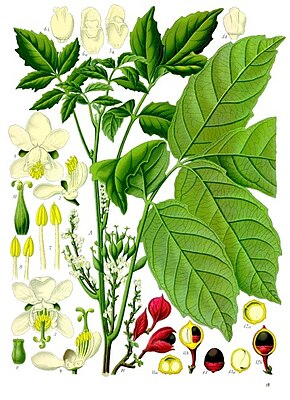Soap tree-like
| Soap tree-like | ||||||||||||
|---|---|---|---|---|---|---|---|---|---|---|---|---|

Paullinia cupana , illustration from Koehler 1887 |
||||||||||||
| Systematics | ||||||||||||
|
||||||||||||
| Scientific name | ||||||||||||
| Sapindales | ||||||||||||
| Yuss. ex Bercht. & J. Presl |
The soap tree-like (Sapindales) are a plant order of the flowering plants (Magnoliopsida).
description
Depending on the family, they are woody or herbaceous plants .
In each flower there are twice as many stamens as there are petals . There is always a discus .
Systematics
The Sapindales are within the Eurosiden II the sister group of the ( Huerteales + ( Brassicales + Malvales )).
In the order Sapindales there are nine families with 460 genera and 5670 species :
- Sumac plants (Anacardiaceae) are trees , shrubs or woody climbing plants. There are 70 to 82 genera with 600 to 800 species.
- Biebersteiniaceae are annual to mostly perennial herbaceous plants . There is only one genus with four to five species, spread from Greece to Central Asia :
- Balsam trees (Burseraceae) are trees or bushes. There are 18 genera and 550 species.
- Kirkiaceae are trees or shrubs. There are one or two genera and six to eight species in tropical and southern Africa and Madagascar .
- Mahogany (Meliaceae) are trees with bitter bark. There are two subfamilies with 52 genera and around 621 species.
- Nitrariaceae (Syn .: Peganaceae and Tetradiclidaceae) are shrubs. There are three genera and around 16 species in the arid regions of the northern hemisphere and Australia .
- Diamond plants (Rutaceae): There are very different growth forms, from herbaceous plants to trees; about 161 genera and about 1815 species.
- Soap tree plants (Sapindaceae) are trees or lianas . There are four subfamilies with around 135 genera and around 1580 species.
- Bitter ash family (Simaroubaceae) are trees or bushes. There are about 19 genera and about 95 mainly tropical species.
swell
- The order of the Sapindales on the AP website . (engl.)
Individual evidence
- ↑ Angiosperm Phylogeny Group : An update of the Angiosperm Phylogeny Group classification for the orders and families of flowering plants: APG III. In: Botanical Journal of the Linnean Society. Volume 161, No. 2, 2009, pp. 105-121, DOI: 10.1111 / j.1095-8339.2009.00996.x
Web links
Commons : Sapindales - collection of images, videos and audio files